Agouti
Agoutis are instantly recognisable by their flecked coats. Unlike monocoloured Selfs, Agoutis have multicoloured ‘ticked’ coats, with two different colours alternating all over the back, head and legs. Only the stomach of the normal Agouti is monocoloured, and often the fur immediately around the eyes. A new variation of the Agouti is the Solid Agouti, which has the ticking pattern on its stomach as well as its back, face and limbs. This is a relatively new type, and so at present is relatively rare.
Agoutis come in a variety of colours, and the distinction between the two ticking colours can vary - Agoutis with very contrasting ticking colours are much easier to identify than those with more similar tones, such as on a chocolate Agouti. If you’re trying to take your Agouti to a competition, you’ll meet with success if it has even ticking across the body.
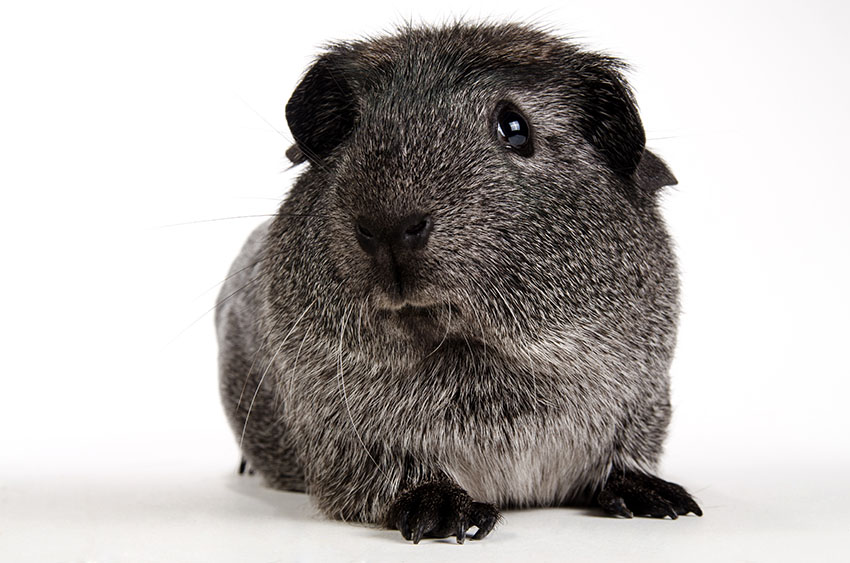
Agoutis have a very distinctive, 'ticked' colouration
Argente guinea pigs are similar to Agoutis in that they have ticked coats, however the Argente ticking is a different type. Unlike Agoutis, Argentes have hairs which are multi-coloured, creating a ticking effect by the dual-coloured nature of each individual hair rather than having lots of differently coloured hairs.
Argentes only come in a few light colours, ranging from white and lilac to golden and beige. Unlike most guinea pigs, they have a very noticeable pink tinge to their eye, which, when combined with their interesting coat, makes them easy to pick out in a group.
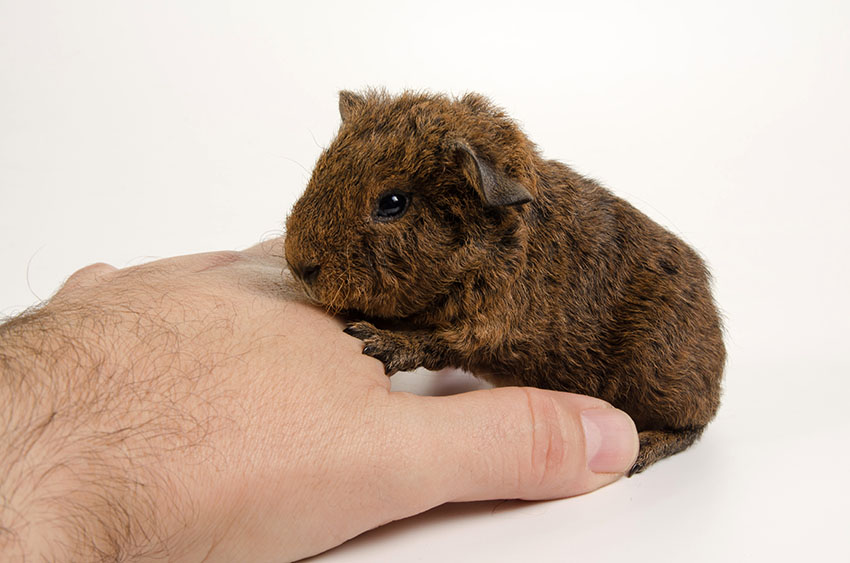
Argentes have multicoloured hairs
Bicolours, as you probably can guess, are guinea pigs with a bicoloured coat. Guinea pigs of this type have the colour distributed in patches across the body. The patches can be almost any colour, Agouti or Self, but they must not be black and red, otherwise they’d be a Tortoiseshell.
This is a popular guinea pig, and still more popular are those who make up good examples. Guinea pigs that are to be shown should have their square-cut patches made up of solid colour, with the minimum of overlap and brindling. Patches should be placed on either side of the centre of the guinea pig’s back, rather than being in the middle or on the extreme edge of the guinea pig.
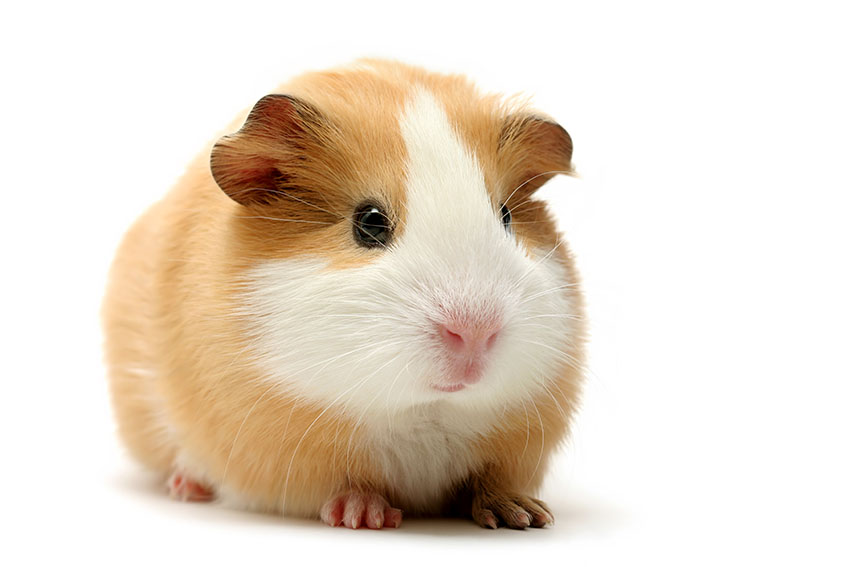
Bicolours come in lots of different combinations
Brindle guinea pigs are much like tortoiseshells in their colouring, but with this variety the coats intentionally have mixtures of colours, rather than being organised into square patches. Brindles ideally have the hair as intermingled as possible, but patches of predominantly red or black do still occur.
These animals have bright eyes and glossy fur – but this need not be smooth. For example, brindles can be of the Abyssinian variety.
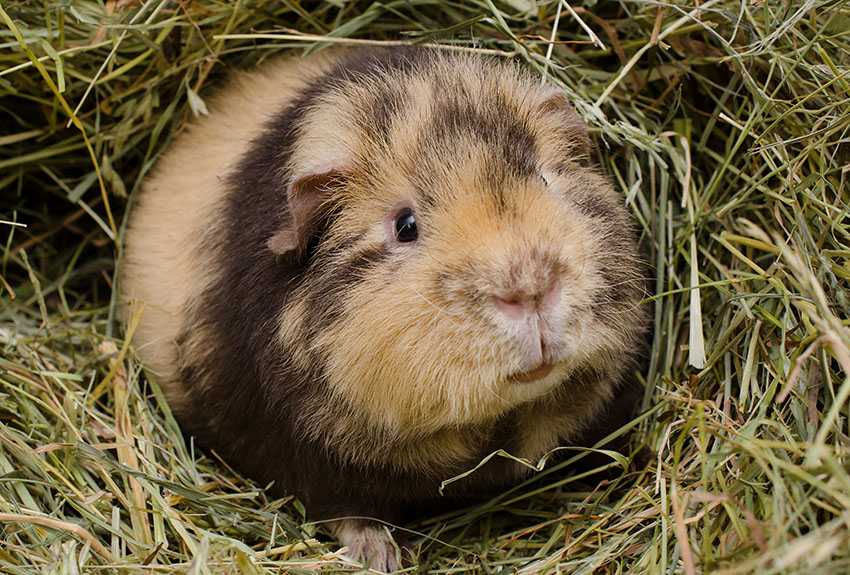
Brindles have lovely mixes of colour
The sensibly named Dalmation guinea pigs possesses markings similar to those of the dogs of the same name. These guinea pigs have large patches of colour on their faces, with rarely any spotting worth mentioning in that area: exemplar animals have nought but a bright white streak down the centre of their face, and coloured feet.
Be very careful if you’re thinking of breeding Dalmation guinea pigs, as breeding two Dalmations together creates a one in four chance of a malformed pup. This is due to the Dalmation gene causing problems if it’s the only gene that’s inherited. Mating a Dalmation and a non Dalmation together will produce about a fifty fifty split of Dalmation and non-Dalmation pups, and will do so safely as the babies can’t inherit more than one Dalmation gene.
Dutch
Dutch guinea pigs come in a variety of colours, both in agouti and monocolour. Like the Dutch rabbit, they have a very distinctive coat with a white chest and front legs, and a different colour (or colours) for their lower stomach and rear.
Dutch guinea pigs come in five colours and five Agouti colours, all of which are made distinctive by the presence of the white area towards the front of the animal. The face should be the same colour as the stomach of the guinea pig, but with a white triangle around the muzzle tapering off towards the top of the head.
There are very strict standards for showing Dutch guinea pigs, most of which surround the specific coat markings that make up the standard. It’s important for the colour of the guinea pig to be even and for its coat to be glossy, but also for its feet to have fine white hair and neat white toenails.
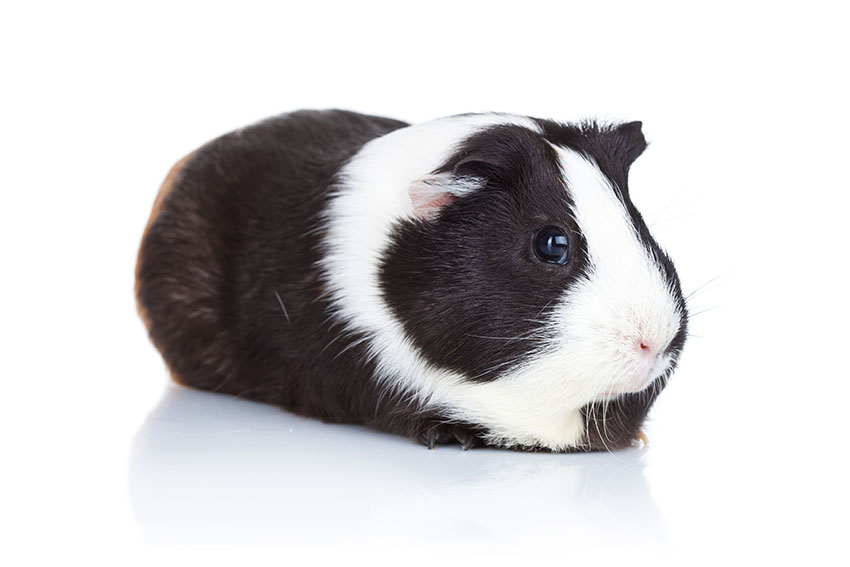
Dutch guinea pigs have a distinct white pattern
Fox guinea pigs are very similar to Selfs, but they do possess a few differently coloured areas that distinguish them. Foxes have pale areas around the eyes, chest and stomach, with a small amount of white ticking elsewhere on the body. They also have interesting features are known as pea spots. These are small, white areas of the coat next to the ears. Other than this, the main colour is solid and should be clearly delineated from the white patches. There are only four shades of Fox – chocolate, beige, black and lilac.
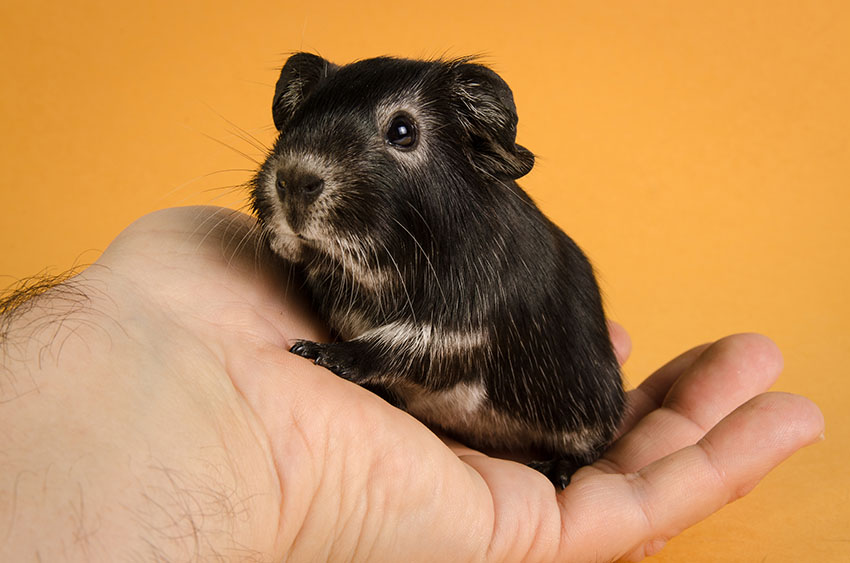
Fox guinea pigs always have some pale areas on their hair
Himalayan guinea pigs are an albino variety, with a predominantly white coat and bright red eyes. For somebody unfamiliar with them perhaps the best way to describe them would be as the guinea pig equivalent of a Siamese cat, due to the fact that these creatures have a striking white coat with darkly pigmented noses, ears and feet
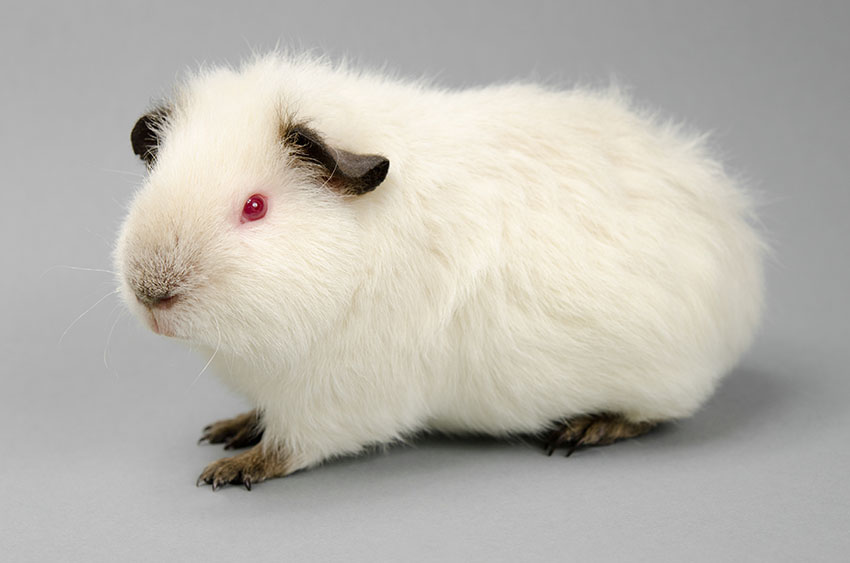
Himalayan guinea pigs have dark patches on their eyes, nose and feet.
Himalayans come in just two shades – black and chocolate. It can be difficult to tell what shade a young guinea pig will become as an adult until they are a few months old. If you’re looking to show your Himalayan, one of the judging points is how stark a contrast there is between the white coat and the dark points. Rather than fading out gradually, the best examples of this breed have very small area of transition between the two colours.
Roan
Roans are bicoloured guinea pigs with no patches, rather with white hairs mixed in with the dominant colour. This pattern usually covers most of the body but not the face or the feet. Roans come in lots of guinea pig colours, and in a variety of coat types. As well as smooth, short coated guinea pigs sporting this colouring, those with wiry and long hair often exhibit it too.
As with the Dalmation gene, the Roan gene can cause problems in guinea pigs that inherit more than one copy. In order to avoid this, it’s wise to mate Roans with non-Roans. Don’t despair – this won’t mean that you won’t get Roan babies. According to the laws of genetics, half of the pups produced will be Roan as the Roan gene is dominant.
Selfs
Selfs are a very common type of guinea pig, coming in twelve different colours including cream, black, chocolate and lilac. Selfs are the same colour all over, with a smooth, non-wiry coat. Depending on the colour of the hair, these animals may also have eyes that aren’t the usual black you’ll find with most guinea pigs, and are instead red or pink.
If you want to show your Self guinea pig, then there are a few specifics judges will penalise: areas of differently coloured hair, and dark patches on the ears. The animal should also have a graceful dip in its back and large, bright eyes.
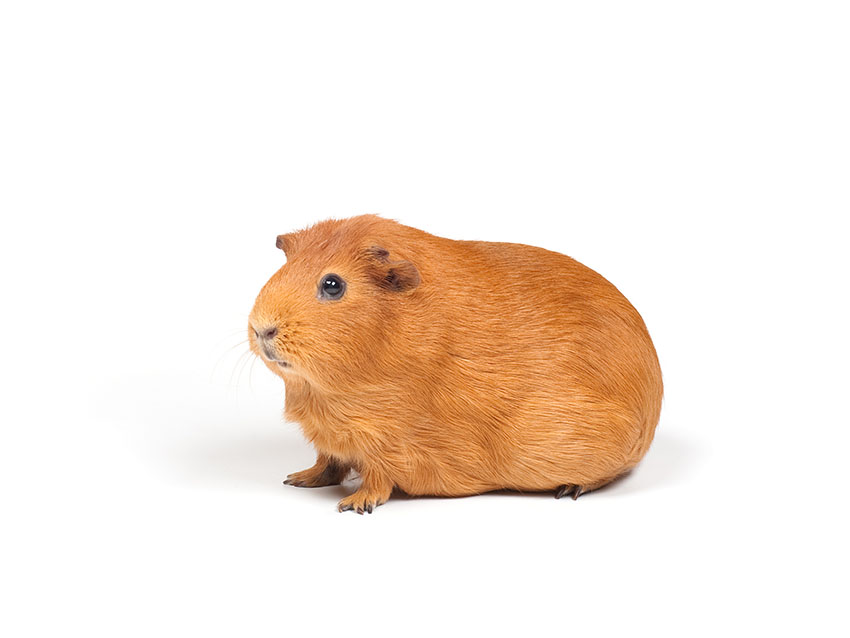
Self guinea pigs are the same colour all over their bodies
The Tan is a non-Self guinea pig with a single base colour and tan areas. Like Fox guinea pigs, the markings should be on the eyes, muzzle and belly, and the guinea pig should have little patches of colour known as ‘pea spots’ next to the ears. Tan guinea pigs come in chocolate, black, lilac and beige, and good breed examples have a nice clean band of orange around the chin.
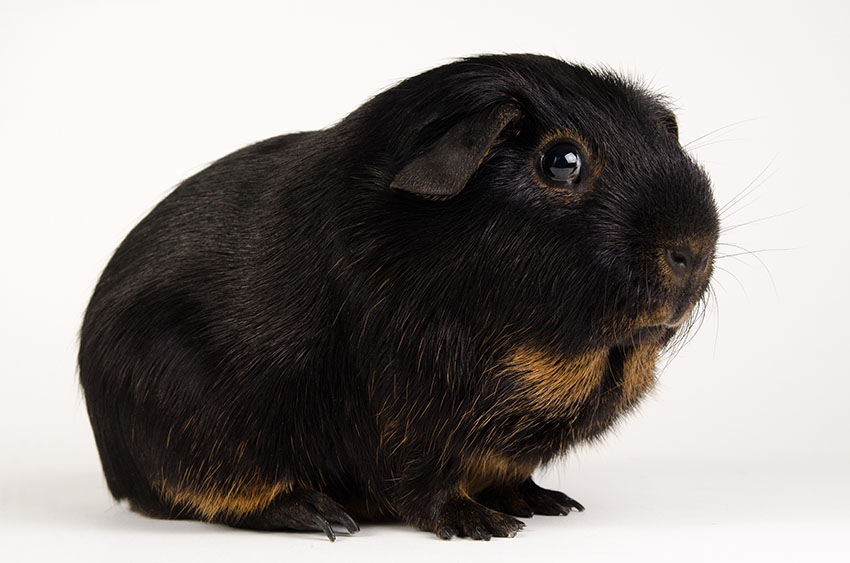
Tan guinea pigs are known as such due to the tan areas on their body
This type of guinea pig is very popular – and for obvious reasons! This non-Self guinea pig has three colours (red, white and black), and those individuals put up for show are really spectacular, with clear and neat delineation between the colours.
There is no set standard for where the three colours should be, only that they are arranged neatly, are of roughly even size and are square-shaped. The head should be two colours, black and white, red and white, or even white and red. One of the things that is penalised within this breed is a coat marking known as brindling. This is where a patch has some stray hairs of another colour, which mars the clean-cut effect the judges are looking for.
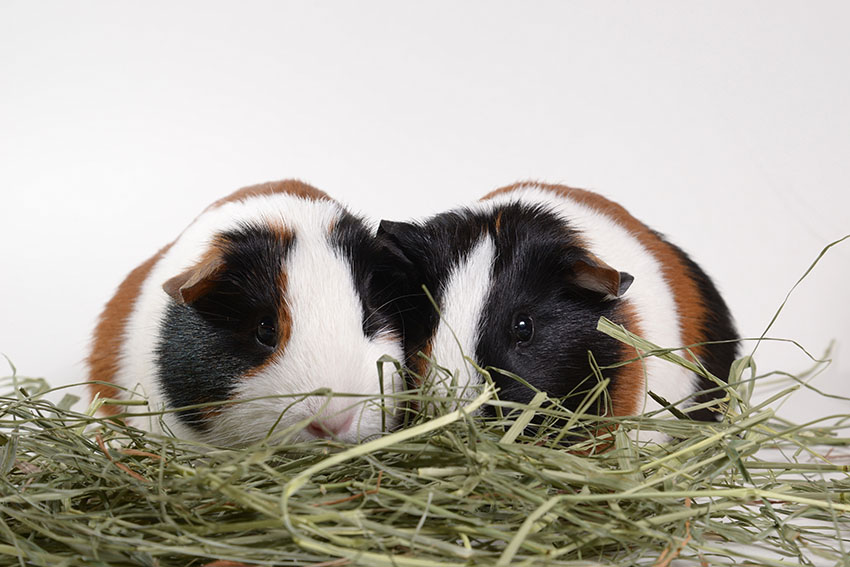
These guinea pigs have wonderfully coloured coats
Tortoiseshell guinea pigs are red and black patched animals, with bright dark eyes. As with most other patch-coated guinea pigs, the exemplar individuals of this type will have square-shaped and well-coloured patches that don’t overlap with the line running down the centre of the guinea pig’s back.
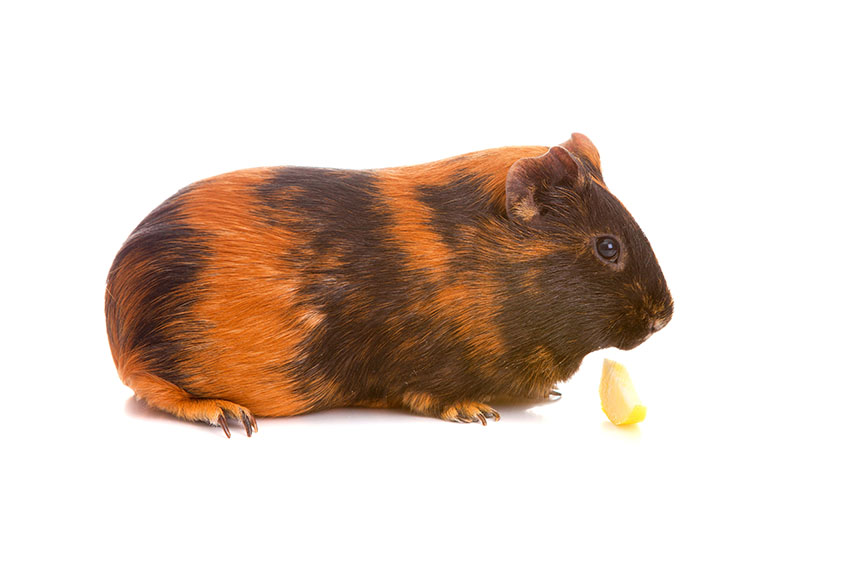
Tortoiseshell guinea pigs are very hard to breed to a perfect standard
In the same vein as Bicolour, you probably know what a Tricolour guinea pig is likely to look like before you see one. Tricolours are guinea pigs with patches consisting of three different colours, with dark or pink eyes depending on their coat. They ideally have square patches that don’t overlap the line of the centre of their back.
Unlike the Bicolour, Tricolours up for show absolutely have to have white patches as one of their constituent colours. Winners will have well-formed patches that are roughly equal in size, as well as a nice solid colour to each patch and with a minimum of brindling.

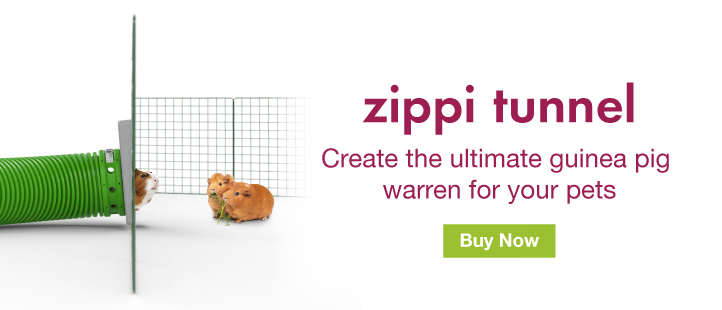

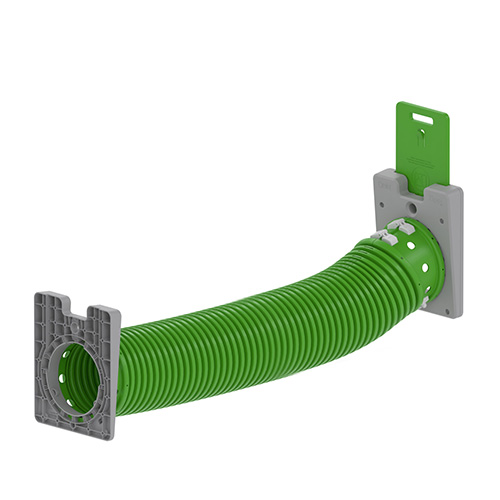
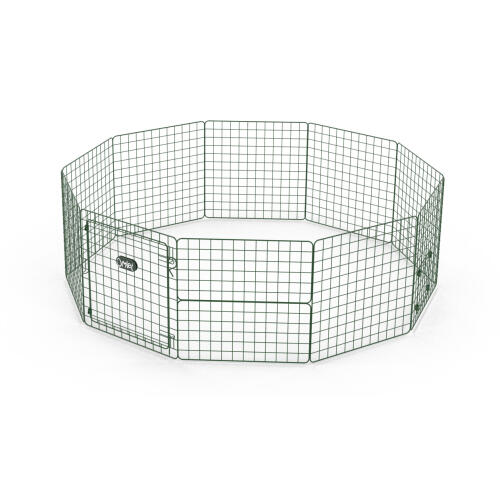
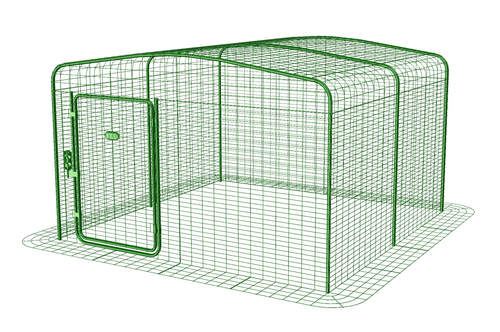
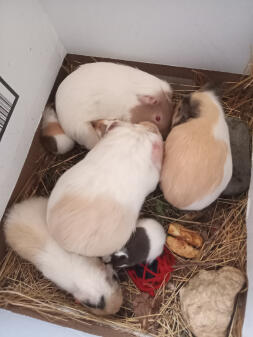
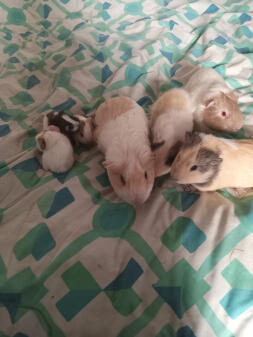
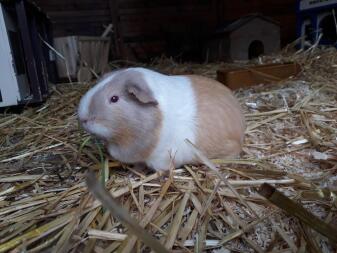
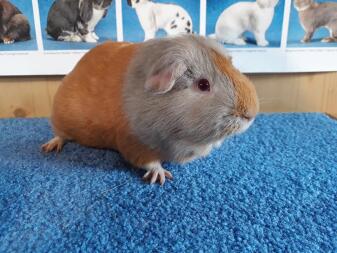
Comments
There are no comments just yet